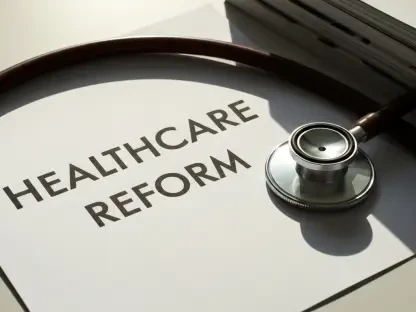Price transparency in the healthcare industry remains an elusive goal. Despite various efforts, patients continue to face challenges in understanding and comparing costs for medical procedures. This article delves into the issues surrounding healthcare pricing, examining whether transparency initiatives are achieving their intended benefits.
The Struggle for Transparency
Background of Transparency Efforts
Healthcare price transparency gained significant momentum with former President Donald Trump’s 2019 executive order. The mandate pushed for hospitals and insurance companies to disclose traditionally confidential pricing data. However, the implementation of these regulations proved to be insufficient and complicated.
Trump’s 2019 executive order marked a bold move to bring clarity to the murky waters of healthcare pricing. The order required hospitals and insurers to provide detailed pricing information that had previously been obscured from consumers. The primary aim was to empower patients with the ability to compare costs for medical procedures and prescription drugs effectively. However, despite the ambitious nature of this directive, the execution fell short of expectations. Hospitals and insurance companies inundated their websites with extensive, often confusing data that was difficult to navigate. Even healthcare pricing experts struggled to interpret the vast amounts of information, leaving regular consumers particularly disadvantaged.
Inconsistent and Confusing Data
Despite the bold intent behind the executive order, hospitals and insurers overwhelmed consumers with vast, complex data. The sheer amount of information often made it difficult for even experts to navigate and understand, let alone the average patient.
The flood of data resulting from the transparency mandate did not translate into clarity for patients. The data sets were complex, and hospitals were inconsistent in how they reported prices. These discrepancies created confusion, rendering the information less practical for consumer use. Analysts and consumers found themselves lost in a sea of numbers that were difficult to compare and understand. The initiative, designed to simplify the cost-comparison process, inadvertently made it more complicated. To make informed decisions, patients need accessible, user-friendly data that clearly outlines their out-of-pocket expenses, something the current reporting system has failed to provide convincingly.
Legislative and Regulatory Challenges
Attempts to Strengthen Regulations
Several members of Congress attempted to pass bills to bolster transparency requirements, but these efforts largely fell flat. Additionally, criticism has been directed at the Biden administration for inadequate enforcement of existing rules.
Despite the initial push for price transparency, subsequent legislative efforts to reinforce these regulations have met with considerable challenges. Some members of Congress proposed bills aimed at strengthening transparency requirements to ensure that hospitals and insurers provide clear and accurate pricing information. However, these proposals failed to gain the necessary traction and were unable to pass. Moreover, the Biden administration faced criticism for not vigorously enforcing the existing transparency rules. Advocates for healthcare reform argued that without stringent enforcement, the transparency initiatives would remain ineffective, unable to drive the meaningful change necessary to benefit consumers.
Advocacy and Public Awareness
Advocacy groups took extreme measures, including purchasing a Super Bowl ad to draw attention to the issue. They accused hospitals and insurers of deliberately hiding prices, highlighting the urgent need for effective transparency.
The impact of advocacy groups on public awareness cannot be understated. These organizations, committed to championing consumer rights, went to great lengths to highlight the importance of price transparency in healthcare. One notable example was the purchase of a Super Bowl ad—an expensive and high-visibility platform—to expose the lack of transparency in healthcare pricing. The ad, which accused hospitals and insurance companies of concealing their prices, brought national attention to the issue and underscored the necessity for robust transparency measures. These advocacy efforts have been pivotal in pushing for reforms and keeping the pressure on government and industry stakeholders to address the transparency gaps that hinder consumer access to critical pricing information.
Quality and Accuracy of Pricing Data
GAO Findings and CMS Response
The Government Accountability Office reported significant issues with the accuracy and comprehensiveness of the reported prices. In response, the Centers for Medicare & Medicaid Services pledged to monitor compliance more systematically and provide better assistance to institutions.
The Government Accountability Office’s findings revealed substantial flaws in the accuracy and comprehensiveness of the pricing data provided by hospitals and insurers. The GAO noted that many institutions were reporting incomplete or inaccurate prices, which added to the difficulty for consumers trying to make informed healthcare decisions. In response to these troubling revelations, the Centers for Medicare & Medicaid Services committed to enhancing the monitoring and enforcement of compliance with pricing transparency regulations. CMS pledged to offer better guidance and support to hospitals and insurers to ensure they understand the requirements and adhere to them. This step was crucial in addressing the transparency issues and improving the reliability of the pricing data available to consumers.
Independent Research Findings
Independent researchers, including the Peterson-KFF Health System Tracker, uncovered instances of “ghost” or “zombie” rates in the pricing data. Such anomalies referenced payments for services that providers could not, or did not, offer.
The findings from independent research further highlighted the complexities and inaccuracies in healthcare pricing data. The Peterson-KFF Health System Tracker, among other research entities, discovered instances of “ghost” or “zombie” rates within the pricing information shared by hospitals and insurers. These rates pertained to payments for services that were either unavailable or inapplicable given the provider’s specialty. For example, dentists and audiologists were reported to receive payments for procedures unrelated to their fields of practice. Such anomalies undermined the credibility of the reported prices and fueled skepticism regarding the utility of this data for making informed healthcare choices. These discrepancies accentuated the need for stringent measures to ensure the accuracy and relevancy of the data disclosed under transparency regulations.
Practical Implications for Consumers
Discrepancies and Variations
Consumers face discrepancies in pricing for identical services within the same hospital and insurer. These inconsistencies further complicate the effort to make informed decisions about medical costs.
The practical implications of these reporting flaws are significant for consumers. Discrepancies in pricing for identical services within the same hospital and insurer have been a common occurrence, often leaving patients bewildered. For instance, a heart attack treatment could have multiple price points within a single hospital under different insurance plans. This inconsistency makes it nearly impossible for patients to ascertain the true cost of their medical procedures. The ability to make informed healthcare decisions relies heavily on possessing clear, consistent, and accurate pricing information. Without this, consumers are left grappling with unpredictable expenses and potential financial strain. These variations in reported prices need redressing to ensure consumers can confidently navigate the financial aspects of their healthcare journeys.
Real-World Examples
One consumer, Theresa Schmotzer, managed to leverage available pricing data to negotiate nearly $3,000 in savings on an outpatient surgery. This success story underscores the potential benefits of transparency, albeit within a sea of challenges.
Despite the widespread challenges, there have been individual success stories that showcase the potential benefits of transparency initiatives. Theresa Schmotzer, for example, was initially quoted $3,700 for an outpatient surgery. By diligently leveraging the pricing data available online and consulting her insurer’s information, Schmotzer successfully negotiated a significantly lower bill, saving nearly $3,000. Her ingenuity in using the fragmented data to her advantage underscores the potential advantages that transparency can offer, even within a system riddled with complexities. Such examples highlight that while the overall landscape remains difficult, consumers who are proactive and resourceful can benefit from the transparency measures in place. It serves as a testament to the need for continued efforts to refine and improve the accessibility of pricing data.
Advocacy from Healthcare Providers
Hospital Associations’ Role
The American Hospital Association expresses willingness to collaborate with federal regulators to ensure compliance. They advocate for comprehensive cost estimates based on individual health plans to better assist patients.
Hospitals have a pivotal role in advancing the cause of price transparency. The American Hospital Association has indicated a willingness to work alongside federal regulators to ensure compliance with transparency requirements. They support the idea that hospitals should provide patients with detailed cost estimates, factoring in individual health plans to offer a clearer picture of their out-of-pocket expenses. This collaboration aims to alleviate the confusion stemming from varied and inconsistent price reporting. By furnishing patients with comprehensive estimates tailored to their specific health plans, hospitals can significantly enhance the utility of the provided pricing information. Such efforts are critical in building trust and enabling consumers to navigate their healthcare costs more effectively.
CMS Initiatives
Since Trump’s initial order, CMS implemented rules to make pricing data more accessible and comprehensible. These include fines for non-compliance and flexible reporting methods, though standardized, reliable data remains elusive.
Since Trump’s initial order, the Centers for Medicare & Medicaid Services have undertaken various initiatives to better facilitate price transparency. CMS introduced several rules to make healthcare pricing data more accessible and user-friendly for consumers. These regulations included imposing fines on hospitals for non-compliance and allowing flexible reporting methods, such as price ranges or historical rates for procedures. While these measures have led to some improvements, the quest for standardized, reliable data remains a challenge. The variability in reporting methods and the persistent inaccuracies in the data have hindered the goal of delivering clear, actionable pricing information to consumers. Consequently, continuous efforts and enhanced enforcement are required to bridge these gaps and render the transparency initiatives genuinely beneficial.
Expert Opinions and Future Directions
Quality of Care Considerations
Experts argue that price transparency must also consider the quality of care. This aspect is often omitted from current data, leading to misconceptions that higher prices guarantee better quality.
A crucial aspect of price transparency that often gets overlooked is the quality of care. Experts in the field contend that any transparency initiative should incorporate quality metrics alongside pricing information. Without these indicators, patients may fall prey to the misconception that higher prices correlate with superior care—much like the perception of premium wine often equated with better taste. Quality metrics, such as patient outcomes and provider reviews, need to be included to give consumers a holistic understanding of the value they are receiving. This comprehensive approach can dispel myths about cost-quality relationships and aid patients in making more informed decisions about their healthcare options. Integrating quality with price transparency holds the promise of driving both cost savings and better healthcare outcomes.
Impact on Costs
Skeptics, such as David Cutler from Harvard University, question whether transparency will lead to lower costs. There is a concern that public pricing information might prompt lower-reimbursed hospitals to demand higher rates.
The debate surrounding the impact of price transparency on overall healthcare costs is ongoing. Skeptics, including healthcare economist David Cutler from Harvard University, question whether transparency measures will indeed lead to reduced costs for patients. There is a concern that making pricing information public could prompt hospitals reimbursed at lower rates to seek higher payments, potentially driving up costs rather than lowering them. This unintended consequence highlights the complexity of implementing transparency initiatives in a way that does not inadvertently exacerbate cost issues. To combat these potential pitfalls, policymakers and healthcare providers must work together to design transparency regulations that foster competition, encourage cost-effective practices, and ultimately benefit consumers.
Mixed Outcomes
Research cited by Trump’s recent executive order indicates a mixed impact: a reduction in the most expensive service prices, yet an increase in the cost of the least expensive services. This highlights the complex outcomes of transparency initiatives.
The outcomes of transparency initiatives have been mixed, adding another layer of complexity to the discussion. Research cited by Trump’s recent executive order showed that the prices for the most expensive services have decreased by 6.3% annually since 2019. Conversely, the costs of the least expensive services have increased by 3.4% annually. This divergence in outcomes underscores the nuanced impact of transparency measures. While some consumers benefit from lower high-end service costs, others face rising expenses for more routine care. Thus, the overall efficacy of transparency initiatives is contingent upon continuous refinement and a balanced approach that addresses the varying levels of service costs. Stakeholders must remain vigilant in assessing these outcomes and adjusting policies to ensure broad-spectrum benefits for all consumers.
Conclusion
Despite numerous efforts, achieving price transparency in the healthcare industry remains a challenging goal. Patients still struggle to understand and compare the costs of medical procedures, hindering their ability to make informed decisions. This ongoing issue is a significant barrier to patient empowerment and efficient healthcare spending.
The lack of clear and accessible pricing information means that patients are often left in the dark about the financial implications of their healthcare choices. This has led to a growing demand for more effective transparency initiatives, aimed at providing clearer, more accessible information.
This article examines the various facets of healthcare pricing issues, questioning whether current transparency initiatives are delivering the promised benefits. We explore potential solutions and the impact these could have on patients and the broader healthcare system. By understanding the barriers and opportunities in healthcare pricing transparency, we aim to shed light on pathways to a more informed and patient-friendly system.









